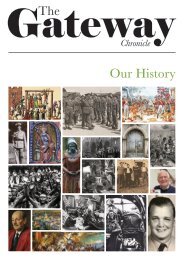Create successful ePaper yourself
Turn your PDF publications into a flip-book with our unique Google optimized e-Paper software.
9<br />
Although the development of medicine was extremely<br />
important for improving conditions for the<br />
Kemet civilisation, the development of agriculture<br />
was even more so. This was because everyone was<br />
able to access the more plentiful food, whereas it<br />
was predominantly just the wealthy who had access<br />
to medicine. Many technological innovations were<br />
developed such as the ox-drawn plough. This used<br />
oxen to pull the plough through the fields which<br />
recycled nutrients within the soil, meaning they<br />
were more successful in growing crops. Therefore,<br />
they had a more stable source of food and nutrition<br />
which is imperative in improving living conditions.<br />
Moreover, this revolutionised agriculture because<br />
it became less labour intensive and more efficient,<br />
allowing them to harvest much larger quantities.<br />
The design was so effective that similar versions are<br />
still being used by farmers in developing countries<br />
in the present day. Another important invention<br />
was the sickle. This was a curved blade used when<br />
cutting and harvesting grain and was significant as<br />
it harvested the staple foods of wheat and barley<br />
Hidden Voices<br />
more efficiently. This helped them gain food security,<br />
thereby increasing their quality of life as they<br />
had reliable access to nutritional foods. This was<br />
more significant than medicine, as if a society is<br />
starving, nutritional food is more important in regaining<br />
strength and health. However, the Ancient<br />
Egyptians irrigation systems which included canals<br />
and dams were the most influential development.<br />
This was because with a reliable water supply, it was<br />
possible to irrigate crops which helped in producing<br />
a constant supply of food, averting disease, malnutrition<br />
and famine. In 3100 BC King Menes, ordered<br />
the first perennial irrigation system to be built,<br />
which diverted water from the Nile into canals and<br />
lakes. This was effective as the River Nile was unpredictable<br />
and the Ancient Egyptians relied on its<br />
seasonal flooding which deposited nutrient rich soil<br />
onto the land. However, the creation of reservoirs<br />
in the canals, meant they could continue to irrigate<br />
crops even when the flood failed. These canals carried<br />
water to numerous farms and villages, so huge<br />
numbers benefitted. This allowed them to create


















